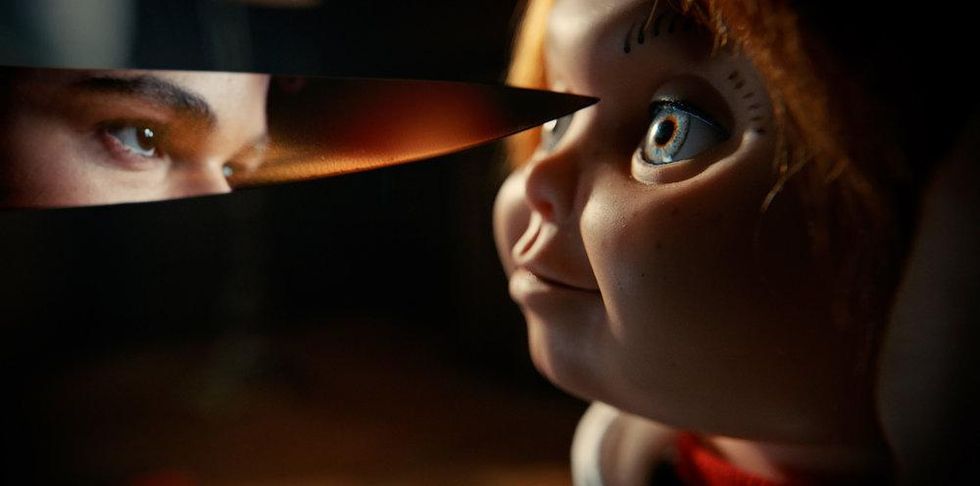
As a kid, Jeff Blackman loved to see the animated artwork that would air between shows on networks like MTV and Nickelodeon.
Now, as the senior vice president of creative, entertainment cable creative & marketing in NBCUniversal’s Television and Streaming Department, Blackman wants to make his own networks just as visually engaging. And he wants fans to be part of the creative team.
So far, they’ve delivered. Ahead of the second season of “Chucky,” a series that follows the character from the “Child’s Play” franchise, NBCUniversal’s cable channel SYFY tapped the film’s fans to make episodic posters for the show. Eight different artists received $2,000 for their work, which resulted in anime-esque reimaginings of the doll and a Christmas-themed animation.
“We had this idea that, if we’re going to turn the brand of SYFY over to the fans, we would want them to create the experience on the TV channel—which, traditionally, only the people that make shows get to make the TV channel,” Blackman says.
To find enthusiastic artists, NBCUniversal turned to Tongal, a Santa Monica-based content creation platform. The way it works is simple. Artists use the platform to showcase their work and market themselves to people looking to hire creatives. Alternatively, companies provide information about specific projects, such as what fanbase they are looking for and digital size requirements. After reviewing artist submissions, the companies greenlight which artists will get funding to complete the project.
For founder and CEO James DeJulio, Tongal was born out of the frustration of seeing talented people be shut out of the entertainment industry, which is notoriously difficult to break into.
“I really wanted to build a system where creative people could begin to unlock their potential and where they would find the opportunity to work with people like [Blackman], who believed in them and who desperately needed to find a way to get closer to creators and their audience,” DeJulio says.
Tongal and NBCUniversal’s partnership has since expanded beyond logo art. For “Jurassic World Dominion,” fans were encouraged to animate dinosaurs in the modern world. The 35 year anniversary of “Back to the Future” was celebrated with people recreating their favorite scenes.
But the process can also get more in-depth. When SYFY wanted to make a documentary about the comic book writer Todd McFarlane, they offered artists on Tongal a budget ranging from $80,000 to $120,000. They also helped those artists coordinate large filming locations. In one case the artists filmed at San Diego Comic-Con and were granted access to McFarlane’s personal archive.
The idea for Blackman is to use Tongal’s network to find creators who have extensive knowledge of the comic book world instead of hiring from a more traditional pool of applicants.
“We need somebody who knows that stuff, maybe has some relationships and prior work in there and then can bring something interesting to the visual storytelling,” Blackman says.
While some companies, like Marvel, have been vocally hesitant to bring fans into their process, claiming that they are too attached to the original plotlines, others have embraced them. Last year, Lucasfilm hired a “Star Wars” fan who had previously made Luke Skywalker deepfakes to work on de-aging and facial visual effects.
For its part, SYFY wants to work with people who are passionate about their intellectual property. According to Blackman, doing so solves two problems: the company doesn’t have to spend time explaining the show to people who are unfamiliar with the universe, and it helps them feature a wide range of skill sets and artistic styles.
“This lets us go really deep with these subsets of fans and audiences and lets them go even deeper on their engagement with the show,” Blackman says.
From DeJulio’s perspective, that level of fan engagement is going to be the key to television marketing. He believes marketing methods that don’t actively engage fans are no longer an effective, long-term marketing model. Instead, bringing in people who want to channel their passion for a show into a creative outlet can become an active part of the marketing process.
“I think, in the future, there’s no way for a show or movie to not get really close to the fan base,” DeJulio says. “The idea of that something just gets created in an ivory tower and then launched out into the world—I don’t know if that’s the long-term marketing model for entertainment.”
From Your Site Articles
Related Articles Around the Web










